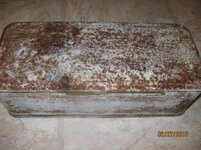Bronze Lifetime
- Messages
- 4,916
- Reactions
- 12,962
How good are "spam cans" for storing ammo?
I've had this spam can around for a very long time, finally decided to open it up and see what was in it. There is a story behind the condition of this can; it spent literally ten years buried in the Oregon woods.
I helped dig it up. It was in a "sealed" plastic drum. Over the course of a decade the drum leaked, and filled half full of good old Oregon rain water. Everything was rusty on the outside.
I was pretty amazed at how well it held up, though. The ammo looks just as nice and shiny as the day it was sealed up. I can't believe what people are trying to sell this old Chinese steel core stuff for at gun shows.


I've had this spam can around for a very long time, finally decided to open it up and see what was in it. There is a story behind the condition of this can; it spent literally ten years buried in the Oregon woods.
I helped dig it up. It was in a "sealed" plastic drum. Over the course of a decade the drum leaked, and filled half full of good old Oregon rain water. Everything was rusty on the outside.
I was pretty amazed at how well it held up, though. The ammo looks just as nice and shiny as the day it was sealed up. I can't believe what people are trying to sell this old Chinese steel core stuff for at gun shows.














